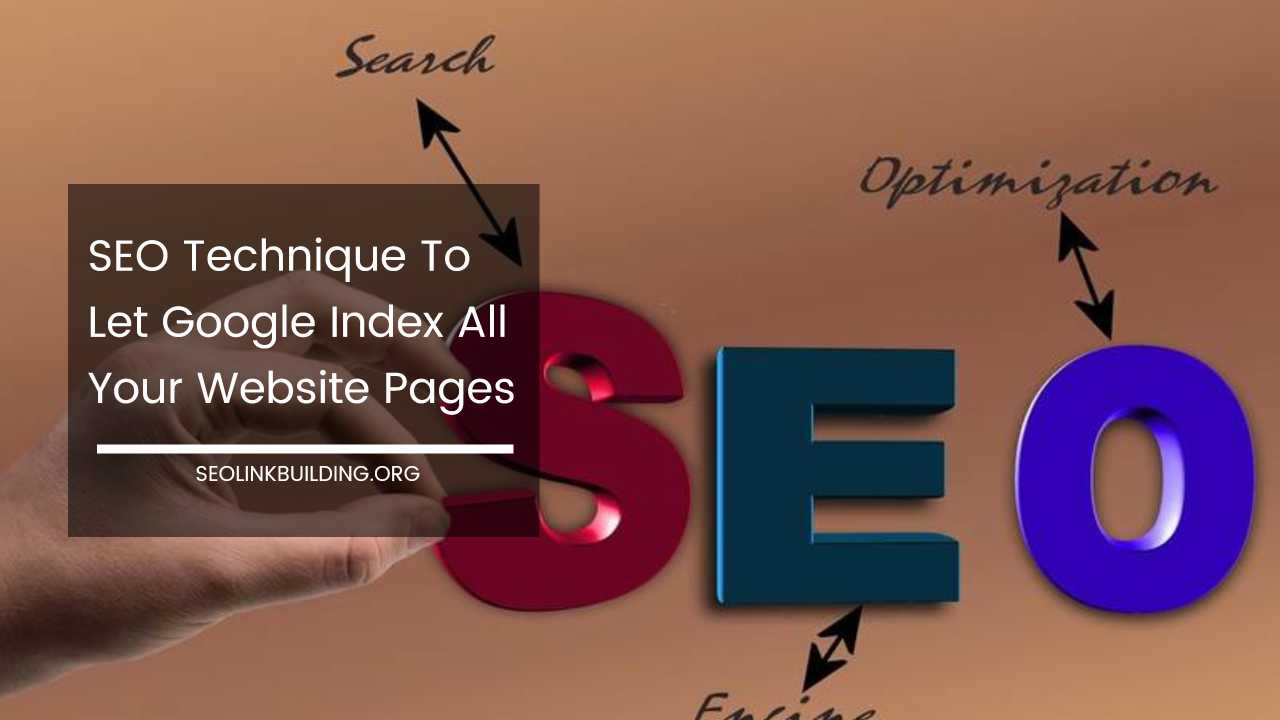SEO Technique to Let Google Index All Your Website Pages

SEO Techniques to Get All Your Website Pages Indexed by Google
A well-indexed website is the cornerstone of a successful SEO strategy. If Google can’t discover your valuable content, it can’t rank your pages in search results, hindering your website’s visibility and organic traffic.
This comprehensive guide explores key SEO techniques to ensure Google successfully crawls and indexes all your website’s content.
Understanding the Crawling and Indexing Process
Before diving into specific techniques, let’s establish a clear understanding of crawling and indexing:
- Crawling: Google uses automated programs called “web crawlers” or “spiders” to scour the internet. These crawlers discover new content by following links between websites and webpages. They constantly update Google’s knowledge of the web, ensuring its search results are comprehensive and up-to-date.
- Indexing: Once a webpage is crawled, Google analyzes its content, extracts information, and stores it in a massive database called its “index.” This is where Google retrieves information when users perform searches.
Factors Affecting Page Indexing
Several factors can influence whether Google indexes a particular webpage:
- Technical Issues: Crawling and indexing can be hindered by technical problems on your website. These can include slow loading times, broken links, mobile-unfriendliness, or errors in your website’s code.
- Content Quality: Google prioritizes high-quality content that is informative, valuable, and relevant to user search queries. Thin content, duplicate content, or content lacking depth and user value may be deprioritized or even ignored by Google.
- Site Structure and Navigation: A clear and logical website structure with well-organized internal linking helps crawlers discover all your pages efficiently. A disorganized structure with complex navigation can make it difficult for crawlers to find and understand your content.
- Robots.txt: This file instructs search engine crawlers on which pages to crawl and index. Accidentally blocking important pages with robots.txt can prevent them from being indexed.
- Noindex Tag: This meta tag tells search engines not to index a specific page. While useful for private pages or login forms, overuse of the noindex tag can prevent valuable content from being seen in search results.
Comprehensive Techniques for Maximum Page Indexing
Here are effective SEO techniques to encourage Google to crawl and index all your website pages:
-
Mobile-First Website Design: With the majority of web searches now conducted on mobile devices, Google prioritizes mobile-friendly websites. Ensure your website has a responsive design that adapts seamlessly across all devices, desktops, tablets, and smartphones. You can use Google’s Mobile-Friendly Test tool (https://developers.google.com/search/blog/2016/05/a-new-mobile-friendly-testing-tool) to check your website’s mobile responsiveness and identify areas for improvement.
-
Optimize Website Speed: Slow loading times can significantly hurt your SEO. Google prioritizes fast-loading websites to deliver a positive user experience. Use website speed testing tools like Google PageSpeed Insights (https://pagespeed.web.dev/) to identify and address any performance issues. Techniques like image optimization, code minification, efficient caching, and a Content Delivery Network (CDN) can significantly improve website speed.
-
Build a Clear and Logical Site Structure: A well-organized website structure with a clear hierarchy makes it easier for both users and search engine crawlers to navigate your website. Strive for a flat site structure where most important pages are within two to three clicks of the homepage. This allows search engines to understand the importance and context of your content.
-
Create and Submit a Sitemap: A sitemap is a file that lists all the URLs on your website. Submitting your sitemap to Google Search Console (https://search.google.com/search-console/about) helps Google discover all your website’s pages, prioritize crawling, and understand their relationships. Most website platforms allow you to generate a sitemap automatically. If your website is built with custom code, you may need to create a sitemap file manually using an XML format.
-
Optimize Internal Linking: Strategic internal linking plays a crucial role in website architecture and SEO. Link to relevant and valuable pages within your website to help search engines discover and understand the context of your content. This also helps users navigate your website and find related information that might interest them. When creating internal links, use descriptive anchor text that reflects the content of the linked page.
-
Focus on High-Quality Content Creation: Consistently create fresh, informative, and valuable content that caters to your target audience’s needs and search queries. Google prioritizes websites that offer unique and valuable content that keeps users engaged. Conduct keyword research to identify relevant topics and search terms your target audience is using. Use those keywords strategically throughout your content, but prioritize creating content that is informative, helpful, and solves user problems. Content should be well-written, free of grammatical errors, and engaging for the reader.
-
Fix Broken Links: Broken links not only frustrate users but can also hinder website crawl efficiency. Regularly check your website for broken links using SEO tools like Ahrefs, SEMrush, or even Google Search Console. When you find a broken link, redirect it to the appropriate webpage or remove it entirely. A clean website with functioning links improves user experience and ensures crawlers can efficiently navigate your site.
-
Use Canonical Tags for Duplicate Content: Duplicate content can confuse search engines and negatively impact SEO. Duplicate content can arise from various scenarios, such as product pages with similar descriptions across categories or multiple versions of the same page with slightly different URLs. If you have duplicate content on your website, use the rel=”canonical” tag to specify the original and preferred version of the page. This helps Google understand which version to index and rank in search results.
-
Request Indexing for New or Updated Pages: Google Search Console’s URL Inspection tool allows you to submit specific URLs for indexing. This is particularly helpful for newly created pages, recently updated pages, or pages you suspect may not have been crawled yet. While submitting a URL for indexing doesn’t guarantee Google will index it, it can help prioritize crawling for those pages.
-
Monitor Crawl Errors and Fix Them: Google Search Console provides valuable insights into website crawling and indexing issues. Regularly monitor the “Coverage” report in Search Console to identify any crawl errors, such as blocked resources, server errors, or “noindex” directives accidentally applied. Addressing these crawl errors promptly ensures Google can efficiently access and index your website’s content.
Advanced Techniques for Enhanced Indexing
For websites with a large number of pages or complex structures, consider these advanced techniques:
-
Paginated Content: If your website uses pagination to display long lists of content (e.g., blog archives, product listings), ensure proper implementation. Use rel=”next” and rel=”prev” link attributes to indicate the relationships between paginated pages. This helps search engines understand the structure of your content and efficiently crawl all pages within the pagination.
-
Structured Data Markup: Implementing structured data markup provides search engines with additional information about your content, making it easier to understand and interpret. Structured data markup can be in the form of Schema.org markup, which uses specific tags to categorize your content (e.g., product information, recipes, events). While not a direct ranking factor, structured data markup can enhance search result snippets, potentially leading to improved click-through rates.
-
Internationalization (i18n) and hreflang Tags: If your website targets audiences in different geographical locations or languages, implement proper internationalization (i18n) strategies. This includes using hreflang tags to specify the language and target region of each webpage. This helps search engines deliver the most relevant version of your website to users based on their location and search language.
Building a Strong Backlink Profile
While not directly related to crawling and indexing, backlinks play a crucial role in how Google perceives the value and authority of your website.
Backlinks are essentially links from other websites pointing to your pages. Earning backlinks from high-quality, relevant websites signals to Google that your content is trustworthy and valuable. Here are some strategies to build a strong backlink profile:
- Create high-quality, link-worthy content: People are more likely to link to content that is informative, valuable, and shareable. Focus on creating content that establishes you as an authority in your niche.
- Guest blogging: Contribute guest posts to other relevant websites within your industry. Ensure the website has a good reputation and allows backlinks in guest posts.
- Broken Link Building: Identify broken links on relevant websites and create content that can serve as a better alternative. Reach out to the website owner and suggest your content as a replacement for the broken link.
Utilizing Social Media Promotion
Social media promotion can indirectly influence indexing by driving traffic to your website. When users share your content on social media platforms, it increases the likelihood of search engines discovering your pages.
Additionally, social media engagement signals can be a factor in Google’s ranking algorithms, potentially boosting your indexed pages in search results.
Long-Term SEO Strategy and Ongoing Maintenance
SEO is an ongoing process, not a one-time fix. Regularly monitor your website’s performance using SEO tools and Google Search Console. Analyze crawl errors, identify indexing issues, and adapt your strategy based on the latest SEO trends and best practices.
By implementing these comprehensive SEO techniques, you can ensure Google crawls and indexes all your valuable website pages.
Remember, a well-indexed website is the foundation for a strong SEO strategy, driving organic traffic, improving brand awareness, and ultimately achieving your website’s goals, whether it’s generating leads, boosting sales, or establishing yourself as a thought leader in your industry.
Additional Tips for Optimal Indexing
- Use a Consistent URL Structure: Maintain a consistent and logical URL structure throughout your website. This makes it easier for users and search engines to understand the hierarchy and organization of your content.
- Submit Your Website to Relevant Online Directories: Submit your website to relevant online directories within your niche. While not a direct ranking factor, it can help increase brand awareness and potentially drive referral traffic.
- Stay Updated on Google Algorithm Changes: Google’s search algorithm is constantly evolving. Stay informed about the latest SEO best practices and algorithm updates to ensure your website remains compliant and optimized for search engine visibility.
- Prioritize User Experience (UX): Ultimately, the goal of SEO is to provide a positive user experience. Ensure your website is user-friendly, with clear navigation, fast loading times, and high-quality content that engages your audience. While not directly related to indexing, a positive user experience can indirectly influence SEO by potentially leading to higher engagement metrics and lower bounce rates, which Google may consider as ranking factors.
Final Thoughts
By implementing the techniques outlined in this guide, you can significantly improve your website’s indexability and ensure Google discovers all your valuable content.
Remember, a well-indexed website is the cornerstone of a successful SEO strategy. By prioritizing high-quality content, optimizing technical aspects, and building a strong backlink profile, you can increase your website’s visibility in search results, attract organic traffic, and achieve your website’s goals.













